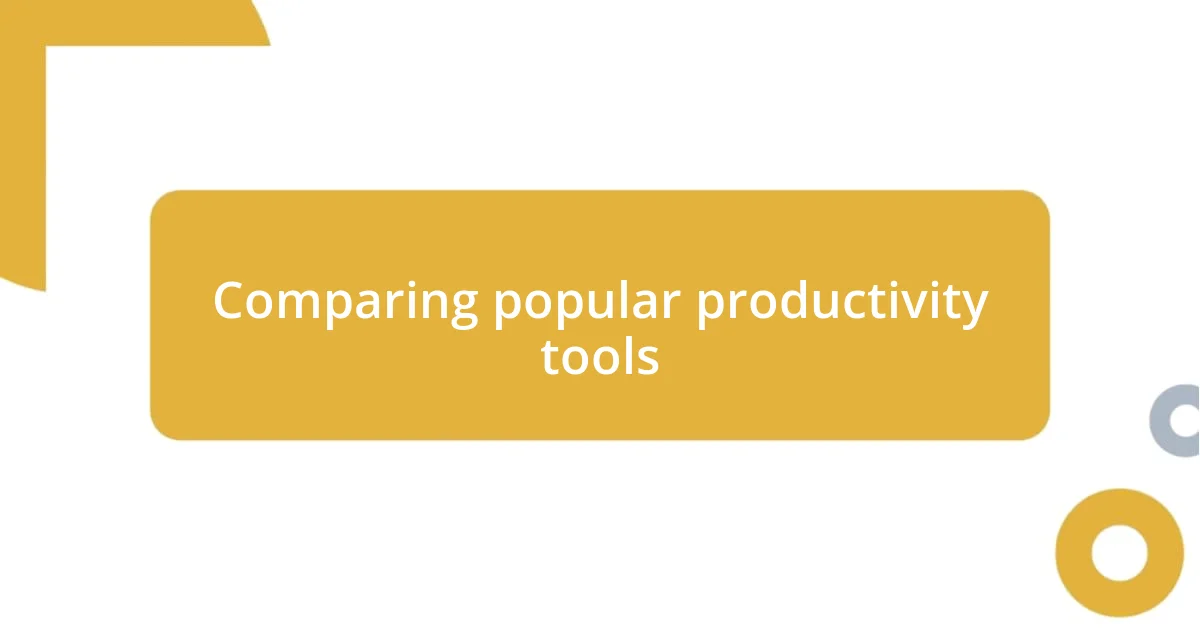Key takeaways:
- Identifying personal productivity needs is crucial; understanding your workflow and integration requirements helps narrow down software options.
- Evaluating key features such as task management, calendar integration, and customization enhances efficiency and helps in selecting the right tool.
- Testing software through free trials and reading user reviews provides valuable insights into real-world performance and ensures the chosen tool aligns with your unique needs.

Identifying personal productivity needs
Finding the right productivity software starts with understanding your unique needs. I remember a time when I was overwhelmed by countless tasks and varying deadlines; I needed a solution that catered specifically to my chaotic schedule. It raises the question: what are the core challenges you face in your daily routine?
As I delved deeper into my own workflow, I realized I needed a tool that could help me prioritize effectively and set reminders for tasks. Think about how you currently manage your time—are you tracking tasks on paper, or are digital notes scattered all over your devices? It’s crucial to pinpoint not just the tasks at hand but also the methods you use to navigate through them.
Once I recognized the need for integration across my tools, my search narrowed significantly. I began looking for software that not only helps with to-do lists but also syncs with my calendar and email. Have you considered how interconnected your tasks really are? This reflection was a game changer for me—it helped me realize that a truly effective productivity tool should fit seamlessly into my existing routine, making life easier rather than complicating it further.

Exploring features of productivity software
Once I started exploring productivity software, I quickly understood that the features available could make or break my efficiency. There are so many options out there, but I needed to focus on what would truly enhance my workflow. I recall feeling lost amidst a sea of choices, but I found that prioritizing certain features not only simplified my search but also began to illuminate the paths I could take in managing my day-to-day tasks more effectively.
Here are some key features to consider when evaluating productivity software:
- Task Management: The ability to create, prioritize, and track tasks is essential. I love how my chosen software allows me to break projects down into manageable chunks, making even the most daunting tasks feel achievable.
- Calendar Integration: Syncing tasks with a calendar can help you visualize deadlines better. I remember it was revelatory when I could see my deadlines laid out alongside my meetings—planning my day became a breeze.
- Collaboration Tools: If you work with a team, look for software that supports real-time collaboration. I once struggled with miscommunication until I found a tool that allowed us to work on projects together seamlessly, reducing conflicts and increasing productivity.
- Reminders and Notifications: Setting up reminders is a game changer. I used to forget small but important tasks until I started relying on automated reminders, which drastically improved my follow-through.
- Customization Options: A customizable interface can help tailor the software to fit your unique workflow. For me, changing the layout and color-coding tasks made organizing my day much more intuitive and enjoyable.

Comparing popular productivity tools
Comparing popular productivity tools often feels like navigating a labyrinth of options. I remember grappling with different applications and feeling overwhelmed by their endless features. When I finally sat down to list them side by side, I could clearly see which best addressed my needs, leading to a significant boost in my productivity.
Each tool has its strengths. For instance, I found that Trello’s visual board system works wonders for tracking projects but lacks in-depth reporting capabilities. In contrast, Asana provides robust task assignments and deadlines but can feel cumbersome for simple to-do lists. By directly comparing them, I realized that there wasn’t a one-size-fits-all solution, and understanding what each tool excels at made my choice clearer.
Understanding the pricing structures also played a crucial role in my decision. Some tools offer free versions with limited features, while others have robust pricing tiers that provide advanced functionalities. From my experience, I noticed that investment in the right software often leads to significant time savings down the line. It’s worth paying for quality if the tool truly aligns with your daily objectives.
| Tool | Key Features |
|---|---|
| Trello | Visual boards, task cards, and checklists |
| Asana | Task assignments, deadlines, project timelines |
| Todoist | Simple task management, labels, and filters |
| Notion | All-in-one workspace, notes, databases, and collaboration |
| ClickUp | Highly customizable project management, workflows, and integrations |

Evaluating pricing and value
When I began evaluating productivity software, I quickly learned that price isn’t everything. Sure, a lower-cost option might seem enticing, but I found that understanding the value each tool provides was far more important. For example, I initially gravitated towards a free version, only to discover that the limitations left me feeling frustrated as I struggled to keep my team on track. Have you ever felt that sting of picking something that falls short? I certainly have, and it taught me to dig deeper into what I was truly getting for my investment.
As I navigated different pricing tiers, I noticed that higher-priced tools often came with more sophisticated features. I remember a time when I considered a mid-range software that boasted analytics capabilities. While it was pricier than some options, I justified the cost by reminding myself of the potential benefits. It indeed paid off—having those insights boosted my efficiency and helped me make more informed decisions. Evaluating pricing is not just about the cost; it’s about what those dollars can ultimately achieve for your productivity.
In my experience, I’ve come to appreciate that value often comes from how well a tool fits into my workflow, rather than its initial price tag. I once chose a tool that was slightly more expensive but offered extensive integrations with the apps I was already using. That connection saved me countless hours of manual work, making every penny spent worthwhile. I often reflect: is it better to save a few bucks upfront or invest in something that enhances my efficiency? The answer, for me, has always been clear.

Reading user reviews and testimonials
Reading user reviews and testimonials can feel like peeking behind the curtain of a software’s true performance. When I first started exploring productivity tools, I dove into reviews and found gems of real-world experience that often highlighted pros and cons I hadn’t considered. For instance, while many praised a certain app’s interface, others lamented its sluggish performance; those honest insights helped me avoid costly mistakes.
Sometimes, the stark contrast in user experiences can be startling. I remember reading a testimonial where someone described how a tool revolutionized their team’s collaboration, while another user claimed it was a nightmare for their workflow. Reflecting on these varied views made me realize that what works for one person may not fit another—after all, we all have unique work styles and priorities. It’s essential to seek patterns in the feedback, focusing on aspects that resonate with my own needs.
It’s fascinating how testimonials often reveal those little things that might not make it into product descriptions. I recall one user mentioning a specific integration that streamlined their task management. That detail sparked my interest, leading me to research further and ultimately uncover features that truly matched my daily objectives. Have you ever stumbled upon an overlooked function that completely changed the way you arranged your workload? That’s the magic of reading others’ stories; their journeys can guide our decisions in unexpected ways.

Testing software before purchase
When it comes to testing software before making a purchase, I’ve found that free trials can be a game-changer. I remember giving a popular productivity app a shot for 30 days, and that experience really opened my eyes. I initially thought it was going to solve all my issues, but as I explored it, I realized its interface clashed with my established workflow. Has that ever happened to you? You think you’ve found the perfect fit, only to see it doesn’t mesh with how you operate?
During one test phase, I took notes on how the features integrated into my daily routine. I quickly discovered that some tools were just too complicated for my needs. There was a particular time-tracking software I tried; it seemed impressive but became more of a hassle than a help. Ultimately, I decided to pass on it, and I felt relieved. It reinforced the idea that testing is about finding the right match, not just checking off boxes on a feature list.
Being hands-on before purchasing is crucial. I often think about how a short testing period can reveal potential deal-breakers that may not be listed on a website. For example, I was curious about an app boasting seamless team collaboration, but during my trial, I found the chat feature buggy and frustrating to use. That experience made me appreciate the importance of checking for those little details. After all, who wants to invest in something that might hinder collaboration rather than enhance it?

Making the final decision
Making the final decision often feels like standing at a crossroads, especially after investing so much time in research and testing. For me, the decision-making process came down to a few crucial factors that aligned with my goals. I recall staring at my shortlist, feeling a mix of excitement and anxiety—one app felt cozy and familiar, while another seemed sleek and sophisticated. How do you choose when both options spark a flame of curiosity?
I leaned on my instincts during this final phase. Reflecting on my trial experiences helped clarify what truly mattered—would I prioritize interface simplicity over an array of features? I still remember the day I decided; it was almost a gut feeling, one of those moments when everything clicked into place. In the end, I realized it was about finding a tool that not only fit my tasks but also resonated with how I wanted to work. Have you ever experienced that moment of clarity that confirmed your choice?
As I made my choice, I also considered potential long-term implications—could this software grow with me as my needs evolved? I think back to the potential I saw in a particular tool and how I felt this sense of excitement for the future. Trusting that hunch made all the difference; it made me realize that productivity software is not just about tools today but about fostering a productive environment for tomorrow. Isn’t it interesting how our choices can shape our workflow for years to come?













